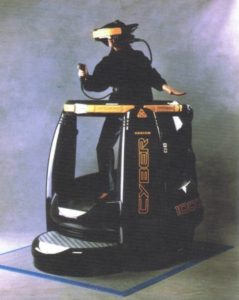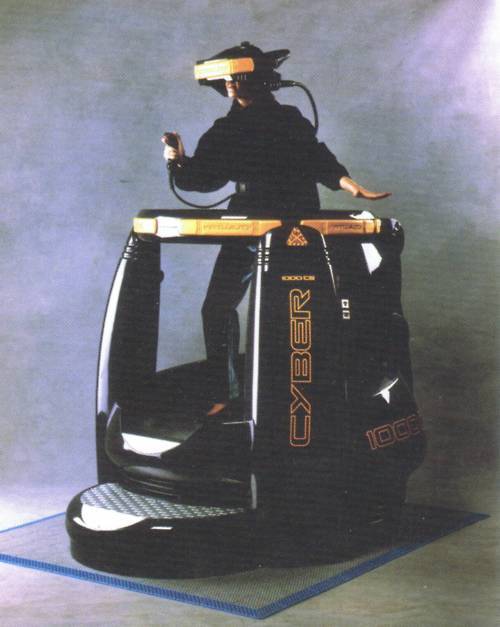If you are reading this on a laptop then we are not in the future yet. How nice would it be to have a nice view of anything from anywhere? Well, that is what virtual reality is aiming for! If you don’t know what VR is, then we are certainly not in the future yet. One minute into the future, changes are being made that will change what the world looks like ten minutes, ten months, and ten years from now! Just down the road (24E to 880N to 84E) big companies are taking big steps towards the pragmatic execution of these immersive technologies. I want to ask (and don’t worry about answering the question since I’m the one typing this) whether or not this VR boom will end successfully or just end?
The reason I posit such a question is because I can’t forget the VR explosion of the 1990s (I actually did forget it because my hippocampus, in the 90s, hadn’t formed to the point where it could retain strong memories). In the 90s, companies like Virtuality became industry leaders. Unfortunately, these companies led VR to its temporary death. The public’s perception of the technology and its realized reality were two very different things. The technology just wasn’t good enough. Games felt awkward and the hardware was too bulky and expensive. The dissonance between dream and reality led to nightmares felt for years. Since the technology was marketed as a gaming system, set standards formed points of reference. Constantly comparing VR gaming systems to the 90s gaming industry only allowed for disappointment. After trying these games, people felt gipped. Gipped. It took quite a while for the American public to look into the future and see VR’s potential.
However, these past few years Facebook, Oculus, Autodesk, Google, HTC, Sony, Amazon, Intel, Microsoft, and Samsung have shown severe interest in the VR and AR fields. However, one specific sector seems to be growing faster than any other. The medical field, within VR/AR, is currently propelling these technologies into fruition.
Now and today, the technology is not really relying on the public to carry it into success. VR and AR startups are coming to rely on themselves…….but mostly on investors. The new DIY attitude that accompanies Silicon Valley is certainly at the center of VR’s potential. Startups are now more likely to start up and move up!
The medical industries are a perfect example of this. From Sight Science to Pro Nova, associating yourself with the growth of healthcare can only bring good fortune and actual fortune. It’s just where the money is headed. Right now, medicine is the most applicable application.
Nicklaus Children’s Hospital in Miami, for instance, has dedicated a good portion of its funding into making virtual reality a reality. With the aid of VR, the Children’s Hospital will help instruct new doctors and patients on what medical school takes years and tears to teach. Having patients understand their own surgery would hopefully make them more comfortable with undergoing it. The simplification of education is definitely a possible possibility in this digital day and digital age.
Shifting the practicality of the VR/AR technology to a privatized field will allow it to develop to advanced levels. In turn, this will ensure that the technology will be ready to face public expectations when it finally reaches the mass market. This time VR and AR’s fate is not up to you…
…but it is up to you because if you are reading this sentence then you probably have some interest in the VR/AR field. That interest is all you need. Get up and startup. VR and AR are nothing without you.
If you are reading this on a laptop then we are not in the future yet. How nice would it be to have a nice view of anything from anywhere? Well, that is what virtual reality is aiming for! If you don’t know what VR is, then we are certainly not in the future yet. One minute into the future, changes are being made that will change what the world looks like ten minutes, ten months, and ten years from now! Just down the road (24E to 880N to 84E) big companies are taking big steps towards the pragmatic execution of these immersive technologies. I want to ask (and don’t worry about answering the question since I’m the one typing this) whether or not this VR boom will end successfully or just end?
The reason I posit such a question is because I can’t forget the VR explosion of the 1990s (I actually did forget it because my hippocampus, in the 90s, hadn’t formed to the point where it could retain strong memories). In the 90s, companies like Virtuality became industry leaders. Unfortunately, these companies led VR to its temporary death. The public’s perception of the technology and its realized reality were two very different things. The technology just wasn’t good enough. Games felt awkward and the hardware was too bulky and expensive. The dissonance between dream and reality led to nightmares felt for years. Since the technology was marketed as a gaming system, set standards formed points of reference. Constantly comparing VR gaming systems to the 90s gaming industry only allowed for disappointment. After trying these games, people felt gipped. Gipped. It took quite a while for the American public to look into the future and see VR’s potential.
However, these past few years Facebook, Oculus, Autodesk, Google, HTC, Sony, Amazon, Intel, Microsoft, and Samsung have shown severe interest in the VR and AR fields. However, one specific sector seems to be growing faster than any other. The medical field, within VR/AR, is currently propelling these technologies into fruition.
Now and today, the technology is not really relying on the public to carry it into success. VR and AR startups are coming to rely on themselves…….but mostly on investors. The new DIY attitude that accompanies Silicon Valley is certainly at the center of VR’s potential. Startups are now more likely to start up and move up!
The medical industries are a perfect example of this. From Sight Science to Pro Nova, associating yourself with the growth of healthcare can only bring good fortune and actual fortune. It’s just where the money is headed. Right now, medicine is the most applicable application.
Nicklaus Children’s Hospital in Miami, for instance, has dedicated a good portion of its funding into making virtual reality a reality. With the aid of VR, the Children’s Hospital will help instruct new doctors and patients on what medical school takes years and tears to teach. Having patients understand their own surgery would hopefully make them more comfortable with undergoing it. The simplification of education is definitely a possible possibility in this digital day and digital age.
Shifting the practicality of the VR/AR technology to a privatized field will allow it to develop to advanced levels. In turn, this will ensure that the technology will be ready to face public expectations when it finally reaches the mass market. This time VR and AR’s fate is not up to you…
…but it is up to you because if you are reading this sentence then you probably have some interest in the VR/AR field. That interest is all you need. Get up and startup. VR and AR are nothing without you.


